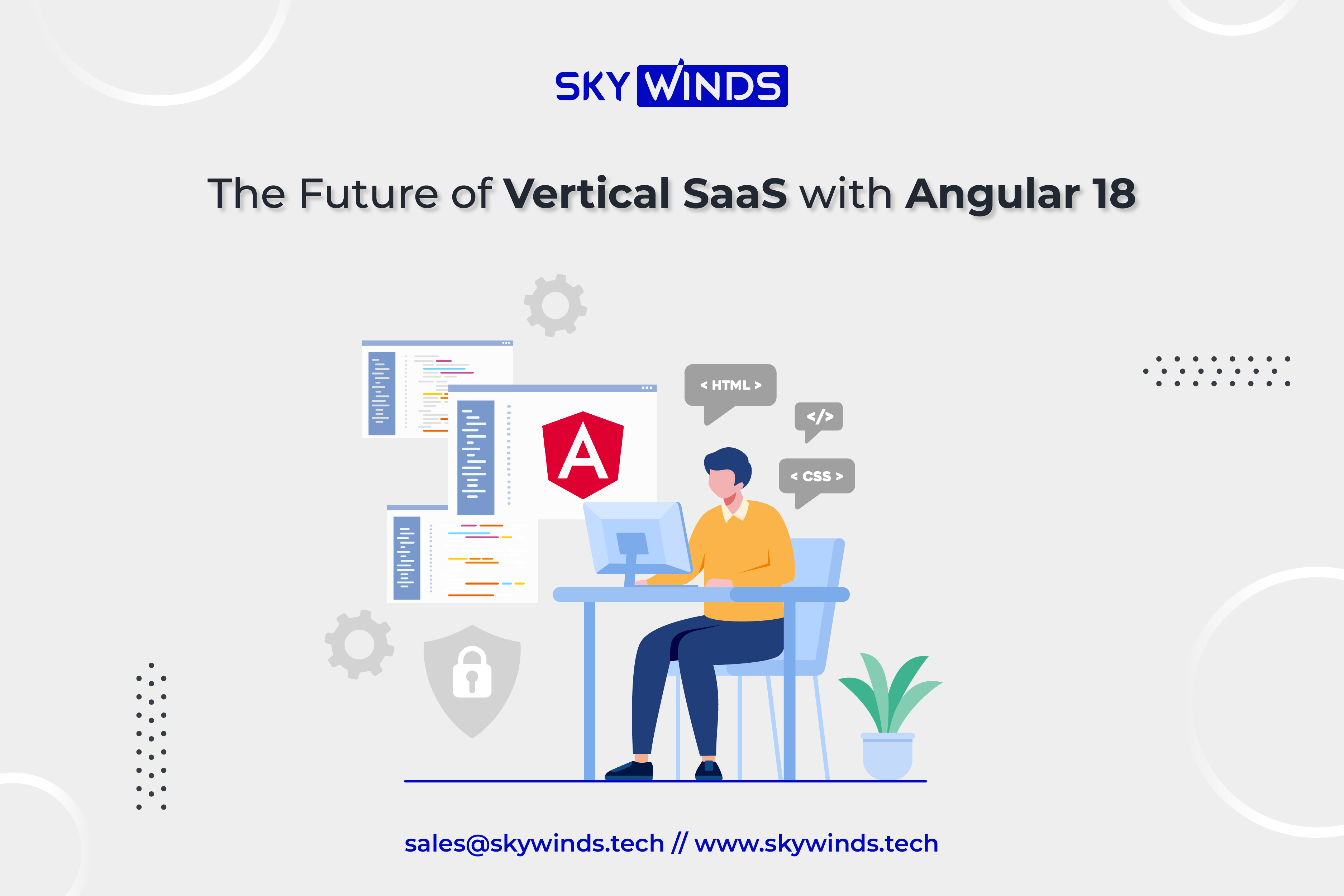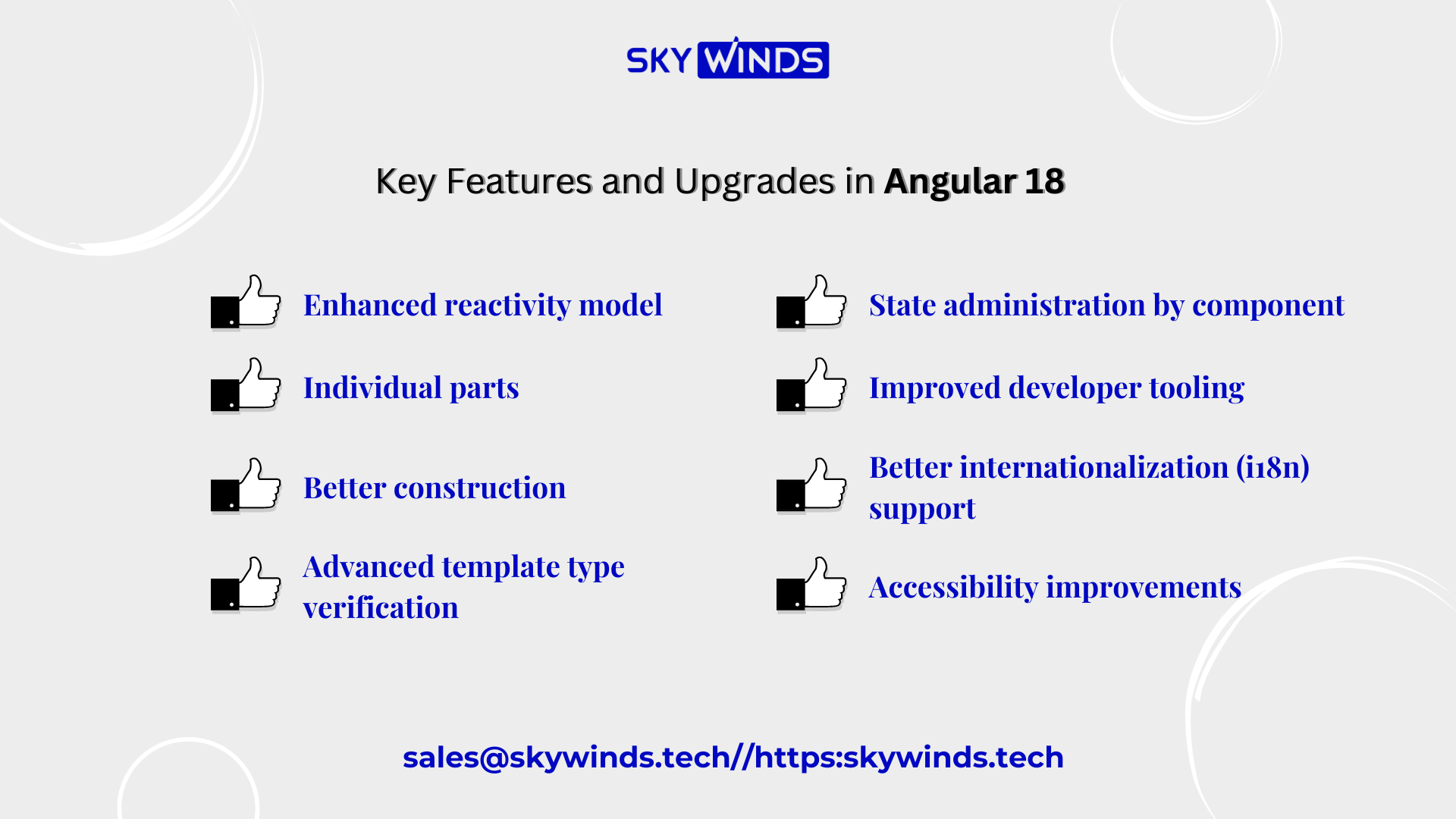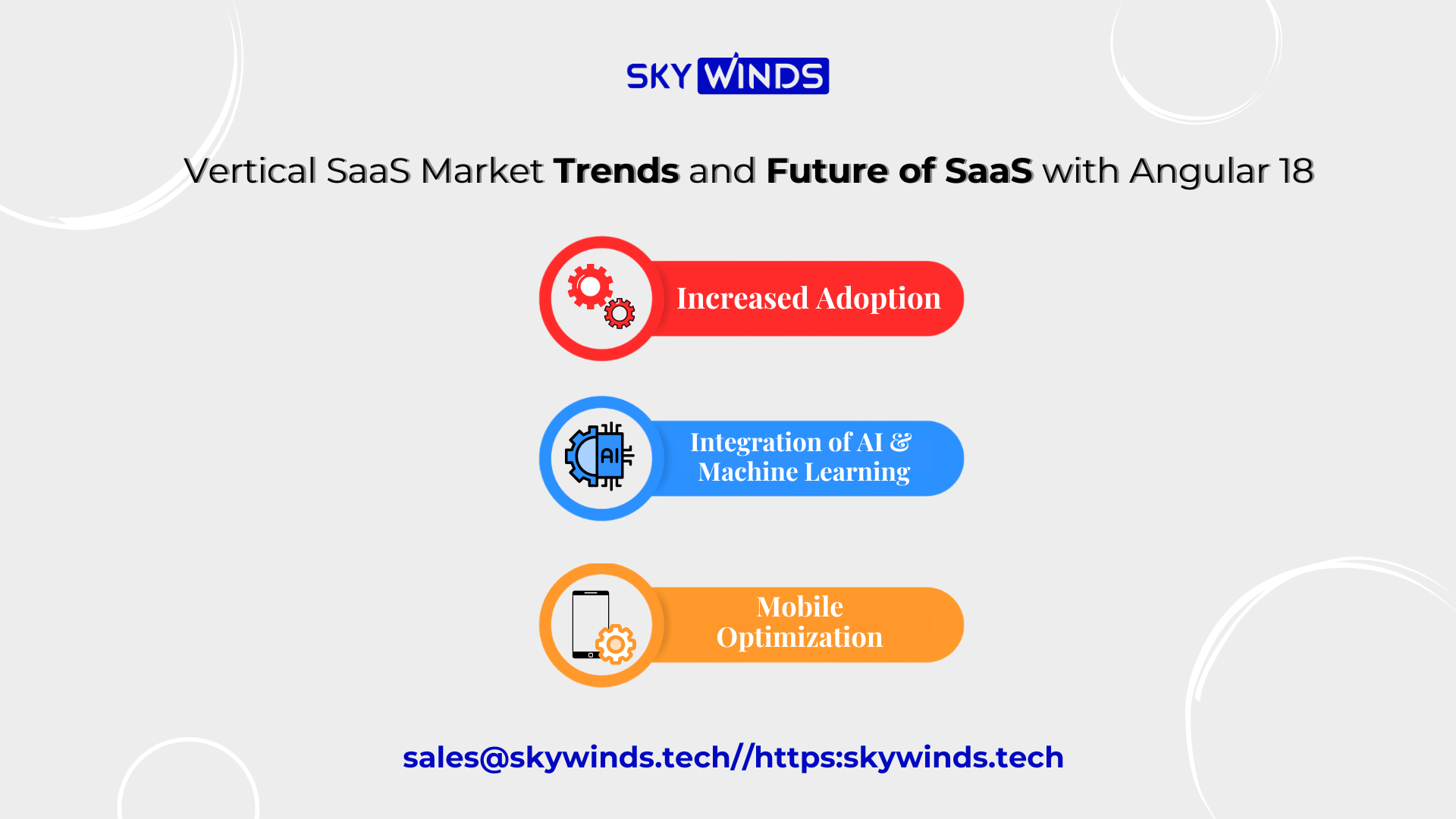
With the release of Angular 18, the potential for these specialized applications is expected to soar even higher. In this blog, we will delve into the concept of vertical SaaS, explore the new features of Angular 18, and examine how this powerful combination can shape the future of SaaS or industry-specific software solutions.
The world of Software as a Service (SaaS) has been evolving rapidly, and one of the most promising developments in this field is the rise of vertical SaaS solutions.
What is Vertical SaaS?
Vertical software solutions is a service solution created for a specific industry, such as retail, financial services, insurance, healthcare or manufacturing. The program is aimed towards industry use, hence the terms “vertical” and “niche.” Because of this, vertical SaaS differs from horizontal SaaS, which caters to a larger user base.
The majority of industries have particular difficulties and needs that might not apply to other sectors.
For instance, one difficulty in the retail industry is giving clients unique experiences in order to keep them and promote repeat business. Healthcare businesses and organizations are obligated to safeguard confidential patient information and guarantee adherence to data privacy regulations, such as HIPAA.
Vertical software solutions that tackle their particular issues are needed by these and other sectors. Vertical SaaS is designed specifically for one or, at most, a few industries.
Vertical SaaS Advantages
Though it is a relatively new idea, vertical SaaS is gaining popularity quickly. A growing number of developers are using a vertical paradigm in place of the traditional horizontal one. Following are some benefits:
- Respects Industry Standards: Goods classified as vertical SaaS are ones that are customized for a certain market or industry. Hence, they must comply with the industry’s rules and regulations for safety, efficiency, and other considerations.
This sets Vertical SaaS vendors apart in a big way. They would find it easier to close the business and turn a profit if they could convince potential customers that their solution is unique since it was created especially to match their needs.
See Also: Angular v16 Features Overview: A Sneak Peek into the Future. - Highly Specific Products: The needs and preferences of their target market must be thoroughly investigated by SaaS suppliers before developing a product that makes use of the Vertical SaaS model. They should focus on a single niche and get to know it very well, as opposed to trying to learn a little bit about every potential user that might use their app.
Understanding Angular 18
A number of new features and improvements are included in Angular 18 with the goal of enhancing scalability, performance, and developer experience. These include enhancements to the Ivy rendering engine, the Forms module, the Angular CLI, Server-Side Rendering (SSR), and differential loading.
Why Angular 18 Matters?
Angular has continuously been the go-to framework for creating robust, expandable, and manageable web applications. Angular updates fix bugs and add modern web development features. Angular 18 is no exception. It should boost developer productivity, app performance, and user experience.
Key Features and Upgrades in Angular 18

- Enhanced reactivity model: Angular 18 brings a more simplified approach to data flow and state management in apps. More intuitive, this model reduces boilerplate code and simplifies complex state interactions. It also enhances performance via optimizing change detection algorithms.
- Individual parts: Standalone components in Angular 18 are highly anticipated. This makes it possible for developers to design components that are independent of Angular modules. It makes them more modular and easier to reuse across different areas of an application or across other projects. Standalone components reduce module management overhead.
- Better construction: Build performance has always been an important part of Angular’s development approach. Angular 18 features a range of enhancements that minimize build times, particularly for large projects. Better caching, incremental compilation, and Angular CLI improvements speed up builds and development cycles.
- Advanced template type verification: This feature helps developers discover issues early in the development process, decrease debugging time and promote code dependability. Complex type scenarios are now supported by advanced type checking, making Angular applications safer and more predictable.
- State administration by component: Services and global state libraries like NgRx have managed Angular state. With Angular 18, developers have the possibility to manage the state at the component level more effectively. For small to medium-sized applications, this feature simplifies state management and makes component state changes and interactions easier to reason about.
@Component({
selector: ‘app-counter’,
template: `
<button (click)=”increment()”>Increment</button>
<p>Count: {{ count }}</p>
`,
})
@ComponentState()
export class CounterComponent {
count = 0;
increment() {
this.count++;
}
}
- Improved developer tooling: Developer tooling has been significantly improved with Angular 18, including Angular Dev Tools support that has been improved. Better insights into dependency management, state changes, and application performance are offered by these upgrades. The enhanced tooling facilitates debugging and application optimization for developers.
- Better internationalization (i18n) support: Angular 18’s internationalization support has been improved to facilitate application localization. New APIs and tools upgrades facilitate the process of translating & managing different language versions of an application. This is particularly advantageous for developers working on applications geared at a worldwide audience.
- Accessibility improvements: Angular 18 maintains accessibility as a top priority, with a number of improvements meant to improve accessibility right out of the box. In order to improve compliance with accessibility requirements, new guidelines and elements are added, which makes it simpler for developers to design inclusive online applications.
Vertical SaaS integration with Angular 18
Angular 18, the latest version of Google’s popular web application framework, brings a host of new Angular 18 features and improvements that can significantly enhance vertical SaaS applications. These applications, specialized to certain industries, can benefit from Angular 18’s powerful framework to provide high-performance, secure, and scalable solutions.
See Also: Unlocking 2024’s Best Micro SaaS Startup Ideas For Tech Entrepreneurs Examples of Vertical SaaS integration
- Healthcare Management Systems: Apps developed for recording patients’ data, appointment scheduling, and telemedicine services.
- Real Estate Management Software: Tools for property management, tenant tracking, and real estate transaction management.
- Platforms for financial services: Services for banking, financial planning, and investment management.
- Manufacturing and Supply Chain Management: Production scheduling, inventory control, and logistics management systems.
Technical Benefits Improved Performance
Improved Performance
- Optimized Change Detection: Angular 18 provides more effective change detection methods, cutting down on overhead and improving application responsiveness. This is especially important for real-time industry-specific apps, such as financial trading platforms or healthcare monitoring systems.
Increased Scalability
- Modular Architecture: The modular architecture of Angular 18 enables programmers to create apps that are scalable. For vertical SaaS apps that need to expand their functionality over time—for example, to add new features to comply with industry regulations—this is advantageous.
- Slow Loading: Angular 18 allows slow loading of modules, which implies that sections of the application can be loaded on demand. As a result, it becomes simpler to scale the application as the user base increases and the initial load time and performance are improved.
Enhanced Security
- Pre-installed Security measures: Angular 18 has pre-installed security measures, like user input sanitization that happens automatically to stop cross-site scripting (XSS) threats. This is vital for vertical SaaS applications that handle sensitive data, such as patient health records in healthcare or financial data in banking.
Vertical SaaS Market Trends and Future of SaaS with Angular 18
Angular 18 features and performance upgrades capabilities are well-positioned to satisfy the expanding needs of vertical SaaS apps. Current trends highlight Angular 18 features and performance upgrades capabilities are well-positioned to satisfy the expanding needs of vertical SaaS apps. Current Vertical SaaS market trends highlight:

- Increased Adoption: As a result of the necessity for specialized tools, more businesses are implementing vertical SaaS solutions to suit their unique requirements.
- Integration of AI and Machine Learning: To offer sophisticated analytics and automation, vertical SaaS apps are progressively incorporating AI and ML.
- Mobile Optimization: To meet the needs of an increasingly mobile workforce, mobile-optimized vertical SaaS solutions are becoming more and more popular.
Future of SaaS integration with Angular 18 will boost efficiency and effectiveness. Future advancements are anticipated to include even more sophisticated user interfaces, leveraging Angular’s powerful component-based architecture to create highly interactive and intuitive applications. This will be particularly beneficial for industries such as healthcare and finance, where user-friendly interfaces can significantly enhance the usability of complex systems.
Challenges & Solutions for Adopting Angular 18 with SaaS
One biggest challenge of Angular 18 integration with SaaS is the learning curve associated with mastering the new features and best practices of Angular 18. To maximize framework capabilities, businesses need to train & develop their teams. To encourage continuous learning and innovation, companies can offer comprehensive training programs and resources.
see also: Exploring the Best 5 Apps for Monitoring Air Quality (AQI) in the USA and CanadaAnother challenge is ensuring seamless integration with existing systems and data. Vertical SaaS applications often integrate with legacy systems and third-party services, making integration difficult. To improve interoperability and data exchange, businesses should use standardized APIs and robust integration frameworks.
Security remains important, especially for sensitive data industries. Angular 18’s built-in security capabilities provide a robust foundation, but enterprises must additionally establish strict security processes and continuously upgrade their applications to handle evolving risks. Vertical SaaS applications must be monitored and secured continuously.
Conclusion
With Angular 18’s specialized, high-performance solutions that can revolutionize apps tailored to particular industries, vertical SaaS has a bright future. Integration of Angular 18 will be essential for promoting creativity, improving security, and guaranteeing scalability as companies look for customized software to fit their specific requirements. Through anticipating market developments and proactively tackling obstacles, organizations can optimize the advantages of this formidable amalgamation, therefore inaugurating a novel epoch of sector-specific software solutions.


